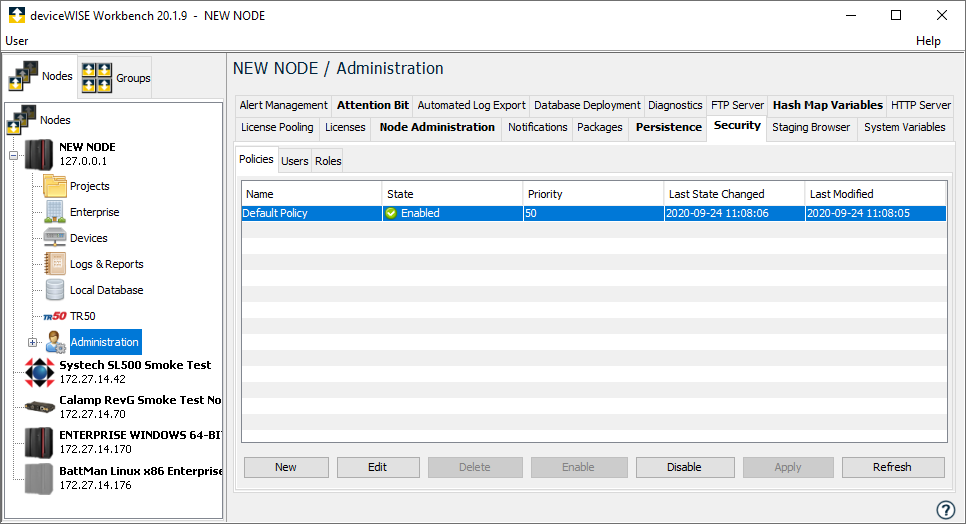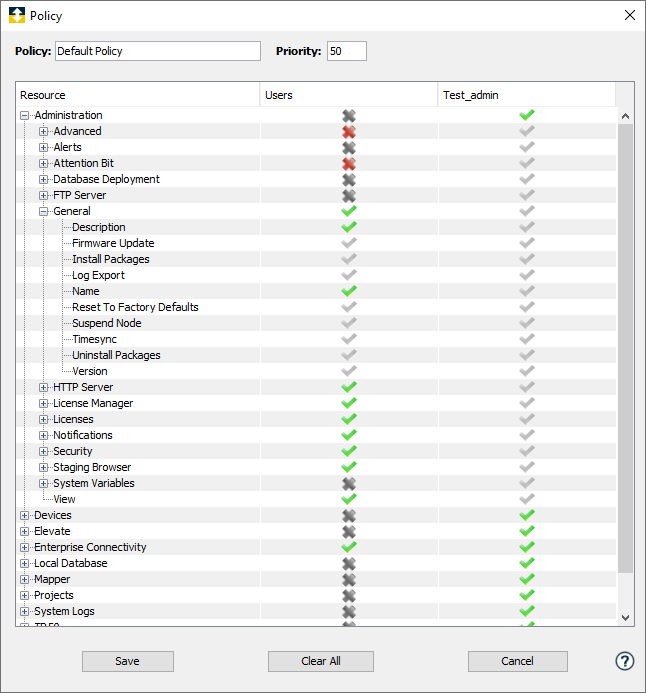The Policies tab displays the defined
policies, their Status of enabled or
disabled, their Priority, their
Last State Change date and time, and their
Last Modified date and time.
A policy named Default Policy is defined for all products.
A policy is where Roles are given access (allowable actions, such as: view, read, write, execute, delete, etc.) to resources.
Users are defined to be members of (or to have) a role.
Multiple policies can be enabled at one time.
Policies have a Priority, which is used to apply precedence to determine a role's access to a resource.
Managing policies
A default policy named Default Policy
is defined with the product. For example purposes, a role
named Test_Admin has been added and given
access to all resources in the policy named Default
Policy, as seen here:
The resources and roles in the Default Policy may vary for the different products, but the general management tasks are similar.
- The column labeled Resources lists the resource categories available on this node. Each category can be expanded and collapsed using the [+] and [-] icons next to the category. When expanded, additional categories or resources are listed.
- Each role is listed as a column, in this example the roles are Users and Test_Admin.
- Note that an admin role is not listed. The admin user is the special system defined user that has access to all resources. This cannot be changed.
- Each resource category (or if expanded, each
resource) has an indication of the access for the
role.
The policy parameters, functions and resource access
indicators are as follows:
| Item | Description |
|---|---|
| Policy | The name of the policy. The policy
named Default Policy
is defined with the product, the
resources and roles may vary for the
different products. |
| Priority | The priority of the policy, a number
from 1 to 100. The policy priority is
used to apply precedence to determine a
Role's access to a
resource. A lower number priority means
a higher precedence. |
| Resource | This column in the table lists the
resource categories and, when expanded,
the resources and actions that access
is granted or denied for each
role. |
| Roles | Each role is listed as a column. In
this example, the roles are
Users and
Test_Admin. |
| Access
indicators
|
The access indicators show whether
access is allowed, including possible
access from a different priority
policy. The indicators are toggled by
clicking them with the mouse. The indicators are as follows:
|
| Save | Save the parameters and access
indicators for the roles for the
policy. |
| Clear All | Reset all access indicators for all
roles to a grey X mark. |
Example policy priority precedence
In the example Default Policy shown above, the Priority is 50. Among other access indicators, the Users role has a:
- Red X mark for the Advanced category
- Grey X mark for the Devices category.
If this policy is enabled and no other policies were enable, then all user names with the Users role would not be able to access the Advanced or Devices resource category, resources and actions.
If there is another policy with a lower priority, for example 75, that is enabled with the access indicators for the Users role being a:
- Green check mark for the Advanced category
- Green check mark for the Devices category.
Then the access for the Users role would include:
- Do not allow access for the Advanced category, since the higher priority (50) policy has a red X mark (do not allow)
- Allow access for the Devices category, since the higher priority (50) policy has a grey X mark (use lower priority policy) and the lower priority (75) policy has a green check mark (allow).
This multiple policy priority precedence function of the Security feature is used to create a layered approach to access control.
 Green check mark. Allow access to
this category and all children, or
allow access to this resource, or
allow access to this
action.
Green check mark. Allow access to
this category and all children, or
allow access to this resource, or
allow access to this
action. Grey check mark. Inherent access to
a resource or an action based on
access to a parent.
Grey check mark. Inherent access to
a resource or an action based on
access to a parent. Red X mark. Do not allow access to
the resource category, or do not
allow access to a resource, or do
not allow access to an
action.
Red X mark. Do not allow access to
the resource category, or do not
allow access to a resource, or do
not allow access to an
action. Grey X mark. Inherent do not allow
access to a resource or an action
based on access not allowed for a
parent.
Grey X mark. Inherent do not allow
access to a resource or an action
based on access not allowed for a
parent.